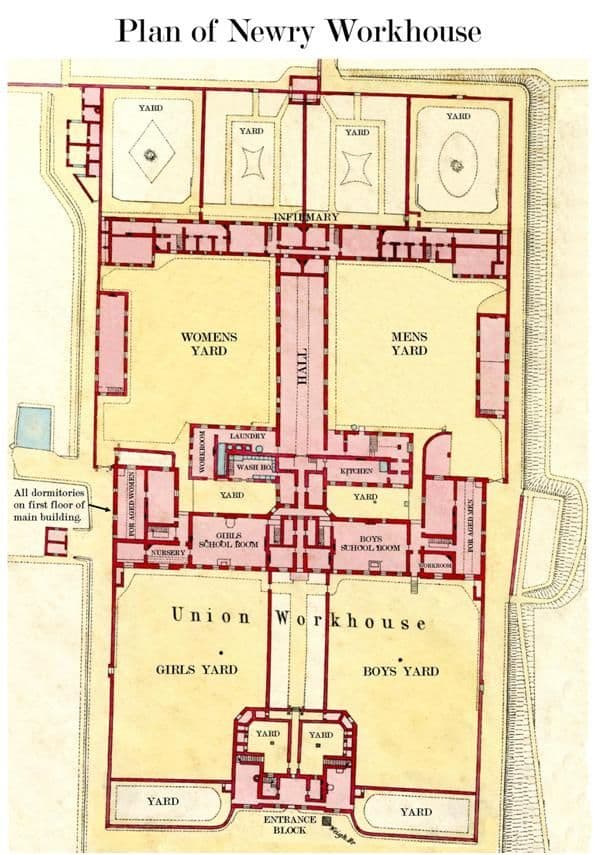CONDITIONS IN NEWRY UNION WORKHOUSE
Saturday, June 30 1849
“The Board of Guardians held their weekly meeting this day at twelve o’clock. Present:- Messrs. J. Ellis (in the chair), I. Corry, JP, W.N. Thompson, JP, G.W. Braddell, R. Clogher, R.Q. Alexander, G. Gray, R. McNaghten, J. Greer, J. Maguffin, T. Markey, R. Harpur, C. Christy, A. Murdock, T. Seaver, M. Hughes, P. Callan, W. Henry.
STATE IN THE WORKHOUSE
FEMALES- Picking oakum, 110; knitting, 12; carding and spinning, 6; sewing 46; sweeping yards, 6; washing, 18; kitchen, scullery and dining hall, 18; nursing infants, 47; in charge of children, 26; attending sick, infirm and idiot-wards, 18; weeding, 6; veining and flowering, 46; total, 359.
MALES- At the mill, 33; labourers, 6; carpenters, 4; whitewashing, 5; painting, 6; shoemakers, 15; tailors, 17; sweepers, 3; carrying milk and coals, 2; digging graves, 2; repairing floors, 2; watchmen, 3; assisting porters, 4; total, 102; grand total, 461.
During the week the women picked ten cwt. of oakum. The earnings of the girls employed at flowering and veining, amount, since the 17th March, to £7. 18s. 4d., which has been placed to the credit of the board. A quantity of early cabbage, grown on the workhouse ground, was sold during the week, producing £2.11s. to the credit of the union.”
The above excerpt has been transcribed from an edition of the Newry Examiner and Louth Advertiser in July 1849. This report gives us a closer look at the types of jobs that were typical in the Workhouse. No one capable of work was allowed to be idle, and jobs in the workhouse included breaking stones, grinding corn, mending clothes, laundry and looking after the children and the sick. The work was often arduous and unrewarding. A corn mill was built in 1849 and the report for the Board of Guardians on the 15th September 1849 states that some of the female paupers grinding Indian corn were working until they fainted.Their hours of work were from 7.30am to 8pm. In response the mill workers were to be relieved every quarter of an hour, rather than every half hour which had been the practice up to that point. The image below shows Newry Union Workhouse on the 1861 Town Plan, added to this are the details of what each space and section were used for. The Workhouse was initially built to accommodate 1,000 inmates. By February 1849, with the addition of an auxiliary Workhouse, it had the capability of accommodating 1,500 inmates.
The 2015 Annual Famine Commemoration will take place on Saturday, 26th September, in Newry. This is the eighth year in which the Great Famine has been marked with a formal Commemoration and the first time that the Commemoration will take place in Northern Ireland.
In recognition of the fact that the Great Famine affected all parts of the island, the location of the annual Commemoration has rotated in sequence between the four provinces since the first Commemoration took place in Dublin in 2008 and falls to Ulster in 2015.
As part of the Museum’s events and activities, we will be looking back each week on the history of the Famine in the local area and how it affected the population of Newry and its hinterland.











